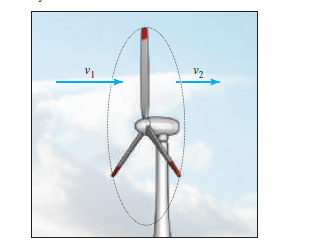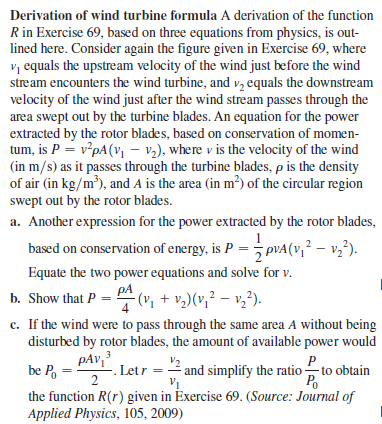V2 Derivation of wind turbine formula A derivation of the function R in Exercise 69, based on three equations from physics, is out- lined here. Consider again the figure given in Exercise 69, where vị equals the upstream velocity of the wind just before the wind stream encounters the wind turbine, and v, equals the downstream velocity of the wind just after the wind stream passes through the area swept out by the turbine blades. An equation for the power extracted by the rotor blades, based on conservation of momen- tum, is P = v*pA(, – v2), where v is the velocity of the wind (in m/s) as it passes through the turbine blades, p is the density of air (in kg/m³), and A is the area (in m²) of the circular region (in swept out by the rotor blades. a. Another expression for the power extracted by the rotor blades, based on conservation of energy, is P = pVA(v,² – v,²). 2 Equate the two power equations and solve for v. pA b. Show that P = " (v, + v,)(v,² – v,²). c. If the wind were to pass through the same area A without being disturbed by rotor blades, the amount of available power would pAv,3 be P, = -. Letr = 2 and simplify the ratio to obtain Po the function R(r) given in Exercise 69. (Source: Journal of Applied Physics, 105, 2009)
V2 Derivation of wind turbine formula A derivation of the function R in Exercise 69, based on three equations from physics, is out- lined here. Consider again the figure given in Exercise 69, where vị equals the upstream velocity of the wind just before the wind stream encounters the wind turbine, and v, equals the downstream velocity of the wind just after the wind stream passes through the area swept out by the turbine blades. An equation for the power extracted by the rotor blades, based on conservation of momen- tum, is P = v*pA(, – v2), where v is the velocity of the wind (in m/s) as it passes through the turbine blades, p is the density of air (in kg/m³), and A is the area (in m²) of the circular region (in swept out by the rotor blades. a. Another expression for the power extracted by the rotor blades, based on conservation of energy, is P = pVA(v,² – v,²). 2 Equate the two power equations and solve for v. pA b. Show that P = " (v, + v,)(v,² – v,²). c. If the wind were to pass through the same area A without being disturbed by rotor blades, the amount of available power would pAv,3 be P, = -. Letr = 2 and simplify the ratio to obtain Po the function R(r) given in Exercise 69. (Source: Journal of Applied Physics, 105, 2009)
College Physics
11th Edition
ISBN:9781305952300
Author:Raymond A. Serway, Chris Vuille
Publisher:Raymond A. Serway, Chris Vuille
Chapter1: Units, Trigonometry. And Vectors
Section: Chapter Questions
Problem 1CQ: Estimate the order of magnitude of the length, in meters, of each of the following; (a) a mouse, (b)...
Related questions
Question

Transcribed Image Text:V2

Transcribed Image Text:Derivation of wind turbine formula A derivation of the function
R in Exercise 69, based on three equations from physics, is out-
lined here. Consider again the figure given in Exercise 69, where
vị equals the upstream velocity of the wind just before the wind
stream encounters the wind turbine, and v, equals the downstream
velocity of the wind just after the wind stream passes through the
area swept out by the turbine blades. An equation for the power
extracted by the rotor blades, based on conservation of momen-
tum, is P = v*pA(, – v2), where v is the velocity of the wind
(in m/s) as it passes through the turbine blades, p is the density
of air (in kg/m³), and A is the area (in m²) of the circular region
(in
swept out by the rotor blades.
a. Another expression for the power extracted by the rotor blades,
based on conservation of energy, is P = pVA(v,² – v,²).
2
Equate the two power equations and solve for v.
pA
b. Show that P = " (v, + v,)(v,² – v,²).
c. If the wind were to pass through the same area A without being
disturbed by rotor blades, the amount of available power would
pAv,3
be P, =
-. Letr = 2 and simplify the ratio to obtain
Po
the function R(r) given in Exercise 69. (Source: Journal of
Applied Physics, 105, 2009)
Expert Solution
This question has been solved!
Explore an expertly crafted, step-by-step solution for a thorough understanding of key concepts.
This is a popular solution!
Trending now
This is a popular solution!
Step by step
Solved in 3 steps with 6 images

Recommended textbooks for you

College Physics
Physics
ISBN:
9781305952300
Author:
Raymond A. Serway, Chris Vuille
Publisher:
Cengage Learning

University Physics (14th Edition)
Physics
ISBN:
9780133969290
Author:
Hugh D. Young, Roger A. Freedman
Publisher:
PEARSON

Introduction To Quantum Mechanics
Physics
ISBN:
9781107189638
Author:
Griffiths, David J., Schroeter, Darrell F.
Publisher:
Cambridge University Press

College Physics
Physics
ISBN:
9781305952300
Author:
Raymond A. Serway, Chris Vuille
Publisher:
Cengage Learning

University Physics (14th Edition)
Physics
ISBN:
9780133969290
Author:
Hugh D. Young, Roger A. Freedman
Publisher:
PEARSON

Introduction To Quantum Mechanics
Physics
ISBN:
9781107189638
Author:
Griffiths, David J., Schroeter, Darrell F.
Publisher:
Cambridge University Press

Physics for Scientists and Engineers
Physics
ISBN:
9781337553278
Author:
Raymond A. Serway, John W. Jewett
Publisher:
Cengage Learning

Lecture- Tutorials for Introductory Astronomy
Physics
ISBN:
9780321820464
Author:
Edward E. Prather, Tim P. Slater, Jeff P. Adams, Gina Brissenden
Publisher:
Addison-Wesley

College Physics: A Strategic Approach (4th Editio…
Physics
ISBN:
9780134609034
Author:
Randall D. Knight (Professor Emeritus), Brian Jones, Stuart Field
Publisher:
PEARSON